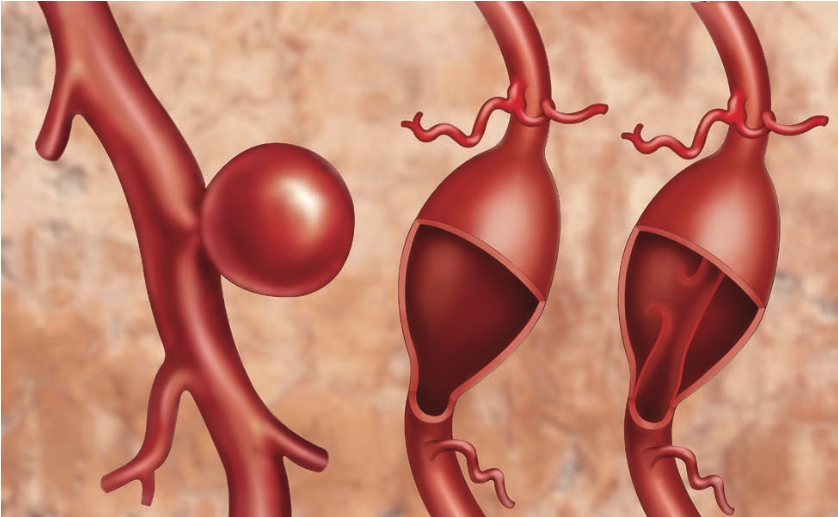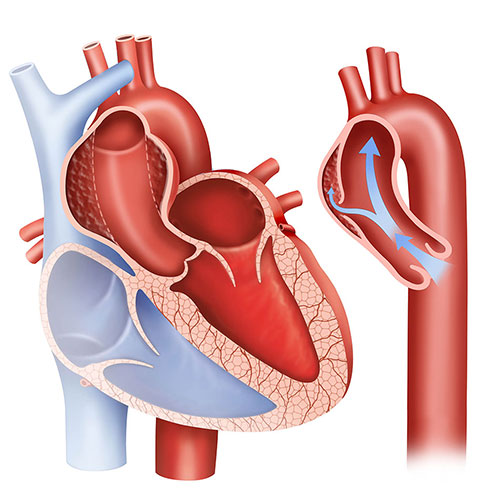1. Causes of aortic aneurysm
Aneurysms can occur throughout the body, but the most common are abdominal aortic aneurysms (Aortic aneurysms). The incidence of aneurysms increases with age, but they can also occur at any age as a result of degeneration, including natural causes, infections, genetics, and trauma. The condition has serious consequences, with approximately 50% of cases resulting in death due to aneurysm rupture if left untreated.
2. Classification of aortic aneurysms
There are two types of aortic aneurysms, affecting different parts of the body:
- Abdominal aortic aneurysm: A bulge that forms along the portion of the aorta that runs through the abdominal region.
- Thoracic aortic aneurysm: A bulge that forms along the portion of the aorta that passes through the chest cavity.
Abdominal aortic aneurysms are more common than thoracic aortic aneurysms. This is because the wall of the thoracic aorta is thicker and stronger than the wall of the abdominal aorta.
Some people develop aneurysms in both the aortic and thoracic walls. This condition is called a thoracoabdominal aortic aneurysm.
For abdominal aortic aneurysmAlthough the exact cause of abdominal aortic aneurysms is unknown, researchers believe that several factors may play a role, including:
- Tobacco. Smoking and all forms of tobacco use constitute one of the most significant factors associated with the development of aortic aneurysms. In addition to the direct harmful effects of tobacco on the arteries, smoking contributes to atherosclerosis, high blood pressure, and accelerates the development of aneurysms.
- High blood pressure . High blood pressure, especially if poorly controlled, increases the risk of developing an aortic aneurysm.
- Infection in the aorta (vasculitis) . In rare cases, an aortic aneurysm can be caused by infection or inflammation (vasculitis) that weakens a portion of the aortic wall. There is often a pattern of aneurysms developing among family members, meaning it may be hereditary.

Aneurysms can occur throughout the body, but abdominal aortic aneurysms are the most common.
For thoracic aortic aneurysm
While the same risk factors associated with abdominal aortic aneurysms can contribute to thoracic aortic aneurysms, several additional factors can lead to a thoracic aortic aneurysm, including:
- Marfan syndrome. People born with Marfan syndrome, a genetic disorder affecting the connective tissues in the body, are at particular risk for thoracic aortic aneurysms. Those with Marfan syndrome may have weaknesses in the aortic wall that make them susceptible to aneurysms. Marfan syndrome often presents with distinct physical characteristics, including tall stature, very long arms, a deformed sternum, and eye problems.
- Aortic injury . There is a higher likelihood of developing a thoracic aortic aneurysm if there has been a prior problem with the aorta, such as a cut into the aortic wall (aortic surgery).
- Injury . Some people who are injured in falls are at risk of developing thoracic aortic aneurysm.
- Aortic surgery is a potentially life-threatening emergency.
3. Manifestations of aortic aneurysm
Aortic aneurysms are almost always asymptomatic. Patients often discover they have an aortic aneurysm incidentally during examinations for other medical conditions.
In the case of abdominal aortic aneurysms, patients sometimes feel an abnormal mass that pulsates with the heartbeat around the navel.
Thoracic aortic aneurysms are often asymptomatic, or present with nonspecific chest pain, and symptoms of compression of surrounding organs such as cough, hoarseness, shortness of breath, difficulty swallowing, or even hemoptysis. When suspected, a contrast-enhanced CT scan of the chest is indicated.

Patients with aortic aneurysms require monitoring and medical treatment at cardiovascular centers.
4. Preventing aortic aneurysm
There is no medication that can prevent aortic aneurysms. Prevention primarily involves controlling risk factors, including high blood pressure, dyslipidemia, and smoking, all of which are risk factors for aortic aneurysms and require continuous treatment and close monitoring. We should:
- Quit smoking and avoid exposure to secondhand smoke.
- Dietary changes: Reduce salt and limit foods high in bad cholesterol, increase consumption of chicken, fish, fruits, vegetables, and whole grains, and avoid sugary drinks and carbonated beverages.
- Avoid strenuous activities: Activities such as lifting heavy objects, mountain climbing, and high-intensity exercise can worsen existing aneurysms. Instead, you should engage in moderate exercise with cardiovascular benefits such as walking, swimming, yoga, and cycling.
- Reduce stress: Try to control your emotions to avoid excessive stress, and take time to rest to avoid constant worrying. This helps prevent blood pressure from spikes and reduces the risk of aneurysm rupture.
5. Treatment options for aortic aneurysm
Patients with aortic aneurysms require monitoring and medical treatment at cardiovascular centers. Surgery is indicated when the transverse diameter of the aortic aneurysm is >5cm or the aneurysm is saccular in shape and of any size.
Currently, there are two surgical methods for treating this condition: open surgery and stent graft placement.
- In open surgery: The surgeon will open the chest or abdomen, remove the aneurysm in the aorta, and sew an artificial graft in place to repair the artery.
- With the continuous development of science and technology, stent graft placement is becoming increasingly popular and has proven superior in the treatment of aortic aneurysms. The surgery time is short (less than 1 hour), and patients can be discharged from the hospital just 2-3 days after the operation. This method is particularly effective for elderly patients and those with multiple risk factors.
However, there is also a relatively high risk of death and complications if co-existing medical conditions, especially cardiovascular diseases, are not properly screened and controlled. After the intervention, patients need to be closely monitored for clinical symptoms to detect complications promptly and manage them in a timely manner.
In summary: Aortic aneurysm is a condition that mainly affects older adults, often associated with severe underlying medical conditions, multiple risk factors, and usually presents with no clinical symptoms or vague, nonspecific symptoms.
Routine screening for abdominal aortic disease should be performed in older patients with multiple risk factors such as smoking, coronary artery disease, and dyslipidemia.
Source



























![[Photo] Prime Minister Pham Minh Chinh attends the Conference on the Implementation of Tasks for 2026 of the Industry and Trade Sector](/_next/image?url=https%3A%2F%2Fvphoto.vietnam.vn%2Fthumb%2F1200x675%2Fvietnam%2Fresource%2FIMAGE%2F2025%2F12%2F19%2F1766159500458_ndo_br_shared31-jpg.webp&w=3840&q=75)










































































Comment (0)